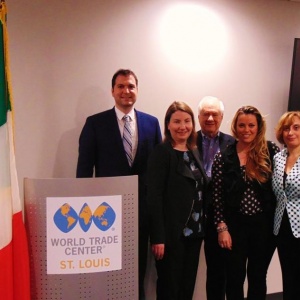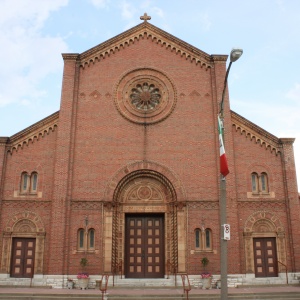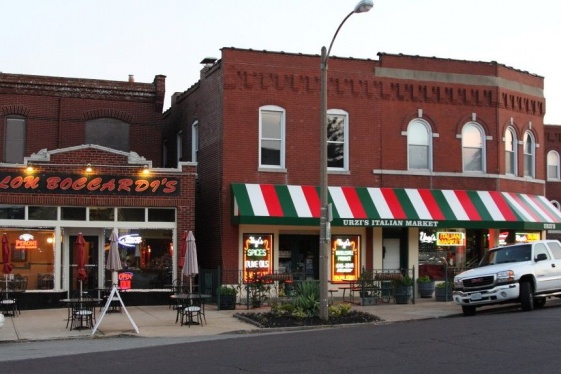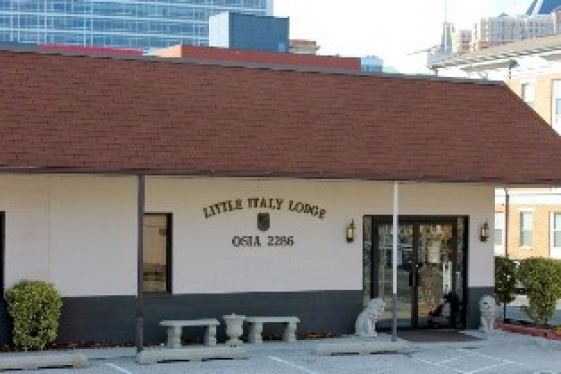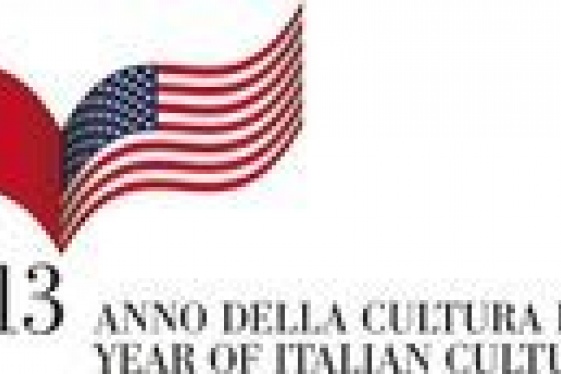
Michael J. Cross (President of the Comunità degli Italiani - St. Louis)
Benvenuti alla Comunità degli Italiani - St. Louis

Oftentimes, Italian or Italian American associations at the center of a community in one of the many American cities are led by exceptional Italian American men or women who have gained over the years the experience necessary to preside over a community that recognizes itself in loving and celebrating Italy. They are sometimes white-haired leaders who, with their charisma, represent Italy in their cities in an exceptional way.
Sometimes, much more rarely, these leaders are younger. They still exceptionally deliver, but they also bring innovation with a younger, dynamic approach. They are two different types of leadership, both winning. Today we meet Michael J. Cross, the young Italian who is revolutionizing the Italian community in Saint Louis, Missouri.
Michael, you are the President of the Comunità degli Italiani – St. Louis. Please tell us something about the history, the activities and the vision of your association, one of the few with an Italian name in the US.
First and foremost, I would like to say that it is truly an honor to be interviewed by We The Italians, one of the most comprehensive publications and media sites dedicated to the relationship between Italy and the United States.
The Comunità degli Italiani – St. Louis, or as we are called in English, the Italian Community of St. Louis, is an official non-profit organization dedicated primarily to Italians living in the St. Louis metropolitan area but also to anyone who would like to learn or practice the Italian language and to those who are simply interested in Italian culture. We represent all Italians who have come to live in this part of the United States and especially the many in our community who have more recently immigrated. These new arrivals are proudly Italian and want to maintain their language, their culture, their customs; but they also desire to share their love for the arts, science, food and literature with the wider community. We are similar to other Italian associations in the US like Italians in DC, for example, in that we provide a “home away from home” for Italians living in our area. We are proud to be the only organization of our kind in the entire Midwest.
You wouldn’t believe it from looking at our Facebook page, but we are a very new organization. We were only founded in October 2017 but it isn’t a surprise, for me at least, that we now represent over 1500 Italians in the St. Louis metropolitan area which includes parts of Southern Illinois and Eastern Missouri. Italian professionals have been coming to St. Louis to work and study for many years but never had an organization which could meet their needs. They never had a voice. There are Italian American organizations and there is St Louis’ version of Little Italy called The Hill, but "Italian" culture from the eyes of Italian Americans is very far removed from the reality of contemporary Italy and consequently, the Italians which have been arriving in the last 5 to 20 years do not feel a close connection with those groups. That is entirely normal in my opinion and occurs within other ethnicities in St. Louis and throughout the United States.
The beauty of our community is that we represent every province of Italy. We also have people in every stage of life. We are professors, doctors, researchers, business owners, musicians, cooks, mothers, fathers, children, grandparents, scientists, exchange students, and those that simply wish to learn the Italian language. Many have come strictly for employment or to study at one of our many universities. Some are here simply because they married a Saint Louisan. Each month we make sure to have at least one event. Many of the events are organized through our club Italiano Per Piacere which holds lectures, panel discussions, and dinners exclusively in the Italian language. In addition to the IPP events, we have pizza parties, concerts, pot-luck dinners, pasta-making parties, wine-tastings, aperitivi, and holiday gatherings all throughout the year. Sometimes families will host these events at their homes which makes it very easy for newcomers and especially families with children to get to know each other. We had a “friendsgiving” this year, for example, which was attended by at least 70 people, 20 of whom were children under the age of 10. The kids really love it. We also have Italian classes for kids twice a month. Many who come to these classes are young families. One or both parents might speak fluent Italian but they would also like their children to grow up in an Italian speaking setting and be able to socialize with other kids in Italian.
Our major events include Carnevale and Ferragosto both of which are highly attended. We introduced these events to the St. Louis area and they are very popular within our community. We are also seeing many Americans who are interested in Italian language and culture take part in these events. We always make sure these events are affordable because we want our students and our families with children to feel welcome. This past year we even had Honorable Fucsia Nissoli attend our Ferragosto celebration. It was the first time that any Italian parliamentarian came to St. Louis and we were certainly honored to have her. Our community does not have a political affiliation and does not endorse any political candidate but it is great to see that we are getting recognition from the Italian government for the work we do for Italian citizens in our area. On that note, I want to iterate that we work closely with Giuseppe Colagiovanni and the Vice-Consulate of Italy here in St Louis, as well as Giuseppe Finocchiaro and the Consulate of Italy in Chicago both of whom have voiced support for our initiatives, have attended our events, and have given me encouragement on a personal level. We also support and sponsor programs which have been in St. Louis for many years such as the St. Louis Italian Film Festival organized by Barbara Klein as well as the Gina Galati’s Winter Opera Saint Louis and Washington University’s annual Paul and Silvia Rava Memorial Lecture in Italian Studies.
I’m convinced that 2019 will be another great year for us. One of our goals is to expand our Italian exchange student program which is already bursting at the seams. Another goal, soon to be realized, is to have the very first public school in Missouri teach Italian classes. This is very exciting and we are working hard and fast to make this a reality for the 2019-2020 school year. Our biggest task for this year is to work towards opening up an Italian language school for all ages and all levels. I have been visiting with numerous Italian communities across the US to obtain ideas. The Italian Cultural Society of Washington DC has a program that I was particularly impressed with. After visiting twice with director Francesca Casazza and with their community, I was able to put together a concrete plan to move forward on this challenging goal for our community. While St. Louis isn’t the size of DC or New York, we are working closely with other language and ethnic groups in the St. Louis area to open up an international language school which will not only teach Italian but many other languages as well. We have a great space for it and now we are looking for the right talent. It will be exciting when this project becomes a reality.
Our vision is comprehensive. We are a real community OF Italians and FOR Italians but also for all those with a passion and love for the Italian language and culture. It is beautiful to see how fast we have grown thus far.
You also have a section dedicated to young Italians, Giovani Italiani Saint Louis. It is a very important topic, that of the young Italians all over the US…
Young people are the future of our community. There are many young professional Italians coming to St. Louis to work at one of our Fortune 500 companies or research at one of our world class universities. Often they bring their families and many times, after living in St. Louis for some years, they chose to stay. Each month, I meet new young Italians who have chosen to work or study here. Some are exchange students and others are entrepreneurs. Often they need assistance with anything from finding an apartment to advice on where to do their grocery shopping. We are here to provide a community for them if they choose. Some come to our monthly events while others may join us once a year. Social media has been very helpful in reaching out to the younger generation, especially instagram, as many young people are no longer using facebook as their preferred social media outlet. Our goal is to let young Italians know that we are here and that they are always invited to whatever we are doing on a particular weekend. Living in another country is not always easy for anyone and we are here as a support group. On any given weekend we might randomly go bar-hopping in the Central West End, watch a movie at The Tivoli, or organize an after-work aperitivo. It’s exciting to see how many friendships have come about from the often random encounters we have.
We also collaborate with the various Italian university programs in the area. Dr. Simone Bregni, famous for his teaching of Italian through videogames, is the director of the Saint Louis University Italian Studies Program as well as their Italian Club. SLU has a vibrant group of students who are eagerly learning Italian thanks to Simone’s ingenious teaching methods. We have put together pizza parties with Simone and his students and we are always happy to encourage more college students to enroll in the SLU Italian program.
This past year we had two important panel discussions which centered on young Italians in St Louis. The first discussion was held with five Italian students and researchers from various universities in our region and centered on the reasons why Italian students are choosing St. Louis as a destination. The other event entitled, Imprenditori Italiani a St Louis, was held with Italian entrepreneurs, small business owners, and startups in our region. Dr. Michele Boldrin, former Dean of Economics at Washington University, led the panel. Boldrin, as you may know, is one of the world's leading economists and came to St. Louis in 2006. The panel discussion was very successful and attracted a lively debate among the participants. Some expressed their frustration with trying to grow their small businesses in Italy while lauding the merits of the American system. Others did not have as positive of a view on their experience here. In all, the panel discussion was a testament to the accomplishments of an increasingly young Italian community.
Among the activities of your association, you reformed the St. Louis – Bologna Sister Cities Organization. What’s the status of this project, officially born in 1987?
Back in 1987, Franco Giannotti, along with several others, founded the St. Louis– Bologna Sister Cities Organization with the cooperation and support of then Bologna Mayor Renzo Imbeni and then St. Louis Mayor Vincent C. Schoemehl. The sister cities organization flourished for over a decade with reciprocal youth summer exchange programs, teacher exchanges, cultural tours, lectures, and scholarship fundraising for college students. By the year 2000 the organization became defunct for one reason or another. In October 2017, after a long period of inactivity, I decided to re-found the sister cities organization along with Franco Giannotti and several other members of our community. A board of directors was formed and, once again, relations between St. Louis and our sister city, Bologna, Italy, were reignited. Today all sister cities organizations in St. Louis are required to be under the jurisdiction of the World Trade Center - St. Louis which is regulated by the City of St. Louis and the St. Louis County governments. We went through a formal re-approval process and were granted once again the status as an active sister city. We also obtained approval from the City of Bologna and from Sister Cities International. Since our funding comes directly from the World Trade Center - St Louis, we collaborate with them very closely. They have benefitted us tremendously and we have been able to make a lot of connections within the St. Louis international community through monthly networking events.
I believe that our sister cities organization is a way of sharing something of Italian culture with our city and region Last year, for example, was the first time an Italian organization participated in the International Institute’s Festival of Nations, St Louis' largest annual multicultural celebration. Over 300 children came to the St. Louis- Bologna Sister Cities booth at the Festival. I was amazed at the turn out. Our booth focused on arts and crafts and children were able to make necklaces and bracelets out of 15 different types of pasta. Painting materials were also provided as children made colorful crafts out of different shapes and sizes of pasta noodles.
This past December we held our first Italian Christmas Concert with mezzo-soprano Benedetta Orsi, a native of Bologna. Around 200 people attended the concert and reception directly following the performance. This was the first time that the Italian community has organized a Christmas concert of this caliber in St Louis. Proceeds from ticket sales helped support Italian Medical Foundation Fanep Onlus in Bologna which assists children suffering from psychiatric disorders. For me, this was a meaningful gift to the City of Bologna in the spirit of the holiday.
People often ask me: Why Bologna? Bologna in fact has a special connection with St. Louis for several reasons. Bologna happens to be the center of agriculture research and food production in Italy just as St. Louis is the center for plant sciences and agricultural technology not only in North America but the entire world. Secondly, Bologna, and its region Emilia Romagna, are famous for the manufacturing of Italy's most famous luxury vehicles: Lamborghini, Maserati, and Ducati. Interestingly enough, before Detroit, St. Louis was the car manufacturing capital of the US from the 1890s until the 1930s when the Moon Motor Car Company produced some of the most stylish American made cars. Lastly, Bologna has the world's oldest university founded in 1099 and St. Louis has the oldest university west of the Mississippi River: Saint Louis University.
Franco Giannotti was not only an original founder of the Sister Cities project: he is also the President of the club “Italiano Per Piacere”. He also owns one of the first Italian American websites ever, with probably the most requested domain in the community: www.italiausa.com Please tell us more about “Italiano Per Piacere” and about Franco Giannotti
A culture dies when its language dies. Any linguist or anthropologist can testify to this fact. When Franco Giannotti, a native of Trieste, founded Italiano Per Piacere in 1999, he understood this very well. He was part of an Italian club in St. Louis which didn’t want to have anything to do with the Italian language. It really didn’t make any sense to him why an Italian club didn’t want to speak Italian. I completely agree with this sentiment. A culture and its language are inseparable. There is no Italian culture without the Italian language just like there is no French culture without the French language. Any language is crucial to the identity of a culture because a culture flows from a language.
As a result, Giannotti gathered like-minded people and founded his own club with the purpose of preserving and promoting the Italian language and culture in the St. Louis region. Not surprisingly, his club has flourished ever since and it is the only exclusively Italian speaking association in the entire Midwest. I joined IPP four years ago and about two years later Franco extended me an invitation to become a board member. I have learned a lot from Franco over these last few years.
The Italian community that we subsequently founded was born from Italiano Per Piacere. We are proud of this club and our membership is increasing. Quite a few Americans, who are fluent in the Italian language or who wanted to practice their Italian, have joined in recent years. It is a great thing to see. In fact, I am one of those Americans who joined. I’m a St. Louis native, although my mother comes from Trieste, I grew up in an Italian speaking household, and subsequently went to live in Europe for several years, so I suppose I am an American with an asterisk. In any case, I fell in love with the Italian language and culture and, as you can see, this is something I am deeply passionate about.
With regards to Franco’s website www.italiausa.com I can certainly imagine that it is one of the most coveted domains between the US and Italy. Franco has always been forward thinking and, at a time where websites were a very new thing, he made the wise decision to purchase it. You will have to ask him if he ever wants to sell but I highly doubt it!
Ah ah thanks, no we’re good with www.wetheItalians.com, but surely his intuition was brilliant.
What’s the story of the Italian emigration to St. Louis?
There are several books on Italian emigration to St. Louis but I will try to paint a general picture. The story of Italian emigration in our region is very similar to that of northern and north-eastern US cities but also unique in its own way. St. Louis was founded by the French in 1764 and ruled by the Spanish for many years until 1804 when the US government purchased the city from Napoleon in the Louisiana Purchase. Like New Orleans, St. Louis was a Catholic city on the Mississippi River. It is, therefore, unsurprising that the very first Italians who came to St. Louis were two missionary priests of the Vincentian order, Giuseppe Rosati of Sora (Lazio) and Felice de Andreis of Demonte near Cuneo (Piemonte). They both arrived in 1817 among other missionaries and Rosati, in fact, went on to become the first bishop of what was then the Diocese of St. Louis in 1827.
The first permanent group of Italian settlers came from the North. They were mostly refugees from the wars that accompanied the Risorgimento. Between 1880 and 1924, St. Louis saw the height of its Italian migrant population. During that time, St. Louis was actually the fourth largest city in North America and a large industrial powerhouse. Many Italians came to our region through New Orleans and up the Mississippi River to work at the 1904 World’s Fair. Others passed through New York and came here via train. The northern Italians came to work in the clay mines which, at the time, were on the city’s western edge. It is there that St Louis’ version of Little Italy was born: The Hill.
You may have heard of baseball greats Yogi Berra and Joe Garagiola. They were both born and raised on The Hill in St Louis. The northern Italians which created The Hill were mostly from Lombardia and specifically the towns surrounding Milan such as Cuggiono. They built a Catholic Church, St. Ambrose, in a Lombard style. It still serves as a focal point of the neighborhood. Southern Italians, mostly Sicilians, settled north of downtown St. Louis. When their neighborhood was blighted, some settled on The Hill to the dismay and even disgust of its residents. Unfortunately, tensions rose between the two groups and many conflicts ensued. To read more about these conflicts, I would recommend “Immigrants on the Hill: Italian-Americans in St. Louis, 1882-1982” by Gary Mormino.
Over the years, Italian emigration to St. Louis has changed dramatically like in many of its peer cities. By the 1970s migration came to a standstill and Americans of Italian descent outnumbered Italians. An interesting phenomenon began to develop. As a result of little or no contact with the mother country and its ongoing transformation, these Americans of Italian heritage began to represent a different culture with their own creole language. Most of them were descendant of poor families and their grandparents or ancestors never learned standard Italian. Decades passed and by the 1970s and 80s these families became proud of their creole culture and language. I think it’s important to understand this transformation and to remember that the early migrants set out as Lombards, Neapolitans, or Sicilians and they brought with them their unique traditions and values which still continued to exercise a significant influence over the lives of their grandchildren and great-grandchildren.
Today, as I have discussed earlier, St. Louis is seeing a new immigration, one of professional Italians to St. Louis and to the United States as a whole. But Italians like to stick together even abroad and we are seeing the formation of many new Italian communities throughout the United States like ours.
Can you please tell us a bit more about The Hill, St. Louis’ Little Italy?
As I mentioned earlier, The Hill is the first settlement of Italians in St Louis. It is important to see the neighborhood in its historical context. It tells a story of historic Italian immigration to the Americas and specifically to the US. Today there are not many actual Italians living on The Hill but there are still quite a few people whose ancestors came from Cuggiono and the towns surrounding Milan.
Today, The Hill is a solid St. Louis working class neighborhood. When fire hydrants begin to look like Italian flags with green, white, and red stripes, you know you’re on The Hill. At the center of the neighborhood on Marconi Street is St Ambrose Church and School. Mass is said in Italian once a month and the school offers Italian classes to all its students. Our community also conducts our Italian classes for kids Imparare L’Italiano Giocando at the parish center.
The Hill is still a vibrant neighborhood although it has changed a lot over the years. The streets are lined with bakeries, grocery stores, a gelateria, and Italian American restaurants playing the music of Dean Martin and Frank Sinatra. The Italia-America Bocce Club, which my uncle Alessandro co-founded, is still regularly used. You will also see copies of the Italian American newspaper Il Pensiero which is still in print and published bi-monthly by Carina Marino.
One of my favorite places on The Hill is Volpi Salumeria, which is also one of our sponsors. In 1898, Giovanni Volpi arrived in St. Louis from Milan, and in 1902, he opened his own salumeria at the same location it is today. He used the same methods he had learned in Milan to cure meats. He even created cacciatore -a dried salami small enough to fit into the pockets of the local clay miners. Today Volpi is a very successful worldwide brand and their products are even imported to Italy. Armando Pasetti, a native of Mantova, and his daughter Lorenza Pasetti, are the owners of Volpi and have been avid supporters of our Italian community.
In 2016 and 2017 the Christopher Columbus statue in Tower Grove Park in St. Louis was vandalized. Now the City of St. Louis is considering removing the statue. What’s your position about this, and what Italy could do?
This has become a very controversial topic and our community has decided not to take an official position with regards to the Christopher Columbus statue. I know quite a few members of our community who are in favor of keeping the statue where it is and I know several people who are adamantly against its presence in any public space. Many are indifferent about the whole issue. In my role as president of the Italian Community of St Louis, I refrain from issuing a position because it is not my place to do so. All I can say is that we condemn all vandalism.
From a personal point of view, however, I will share with your audience some important points to think about. I actually live one block away from the statue and I didn’t even know it existed until I moved to Shaw neighborhood which is adjacent to Tower Grove Park. A majority of St Louisans don’t even know it’s there. We all know that Christopher Columbus was no saint. This is very clear from first-hand accounts and a minimal amount of research. I’ve even gone to Genova and visited his birthplace home. I’ve done my own research. History is history. It is impossible to change it and taking down a statue won’t change anything. Someone would have journeyed to the “New World” from Europe eventually. It just happened to be Columbus. A Columbian exchange of some sort was bound to happen and it was clearly not genocide nor was it intended to be. When two worlds are in contact with each other for the first time, there are bound to be positive and negative effects. That, of course, doesn’t excuse any wrongdoing.
In the past century, Columbus has been an important figure for Italians living abroad, especially here in the United States. I realize that there is an attachment to him and that some consider him a hero. On the other hand, I have spoken to many of our Italian students at local universities who think it is very strange that a discussion on Columbus in 2019 would ever arise. It’s odd for a lot of our Italian newcomers that there is still a conflict about someone who lived over 500 years ago. Some, however, think very strongly that an attack on Columbus is an attack on Italians.
Here is some food for thought. You can take it or leave it. If every statue which represented a controversial figure in the city of Rome would be taken down, there would be no statues in Rome. You would have to take down the entire city. If every controversial figure in the St. Louis Art Museum, a free public space, would be taken down, we wouldn’t have an art museum. I would say to those who wish to take it down to be careful about what they wish for. A lot more statues might follow. Also, the money you would use to take down the statue could be put to better use which would concretely make a bigger difference in our society. Moreover, would you replace the statue with another one? Of whom? Chances are that person will also become unpopular some day. To those who praise Christopher Columbus as a hero to be honored and praised, I would advise to read first-hand accounts and understand his story from a critical perspective. To both sides I would urge respect and understanding but also a critical dialogue.
You may be interested
-
“The Hill” St. Louis’ Little Italy
When the fire hydrants begin to look like Italian flags with green, red and white stripes,...
-
1st Annual Little Italy Cannoli Tournament
Little Italy San Jose will be hosting a single elimination Cannoli tournament to coincide...
-
2015 Bocce Bash!!
Please join Mia Maria Order Sons of Italy in America Lodge #2813 as we host the 2015...
-
2015 scholarship competition
The La Famiglia Scholarship committee is pleased to announce the financial aid competition...
-
30th Annual Art Holiday Walk, Winter Winter...
Holiday walk hours Friday, 12/5 noon-9pm, Saturday ,12/6 noon-9pm Sunday, 12/7 noon-6pm. S...
-
A Week in Emilia Romagna: An Italian Atmosp...
The Wine Consortium of Romagna, together with Consulate General of Italy in Boston, the Ho...
-
A wreath for Columbus and three crowns for t...
The Columbus Day Committee of Atlantic City along with the Bonnie Blue Foundation annually...
-
Emanuele: cervello d'Italia al Mit di Boston
Si chiama Emanuele Ceccarelli lo studente del liceo Galvani di Bologna unico italiano amme...










